info@sikkimtourism.org| +91 98110 66496 , +91 98100 66496
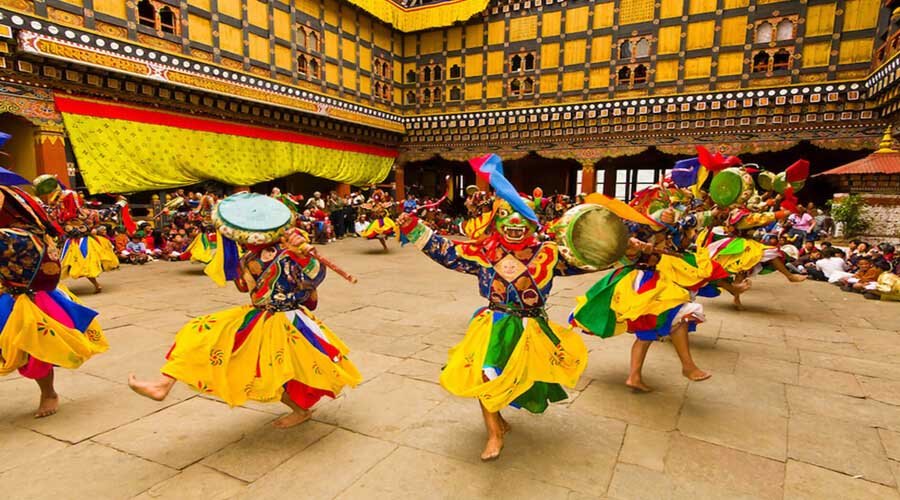
The famous Bumchu Festival is celebrated in the Tashiding Monastery on the 15th day of the first month of the Tibetan calendar. Bhumchu is usually celebrated on the 14th and 15th day of the first month of the Tibetan lunar calendar and these dates usually fall sometime in the months of February or March.
A sacred pot or Bhumchu contains holy water which is believed to have been blessed by Ngadak Sempa Chenpo after he chanted the Mane Mantra five billion times. And Bumchu festival involves the opening of the vessel containing the holy water and revealing it. Bumchu is one of the holiest festivals in Sikkim. The level of water in this vessel is believed to predict the fate of Sikkim for the entire year and is a sign of the what fortune awaits for the people of Sikkim in the coming year. Every year, the vessel is opened to check the level of water in it. It is believed that if the water level in the Bumchu is high till the brim then it is a warning for revolutions and turmoil and if it is lower than what has been specified then ill fortune such as droughts, diseases and various aliments are to be expected. A half-full Bhumchu ushers happiness and predicts that the year will be a prosperous one.
The festivities or the ceremony of checking the water level is accompanied by a special recitation by the devotees. It is a ritual to check the seal of the vase before it is taken out of the case. After opening the vessel, the monks fill seven cups of water from the water of the Bumchu and mix it with water from Rathong Chu. This sacred water is then distributed among the devotees by the lamas of the Tashiding Monastery. To replenish the Bumchu vessel again, seven cups of water are taken from Rathong Chu and poured into the vase to be sealed until the ceremony again the following year. It is miraculous that over the centuries the holy water has not dried up. The water has not even been spoilt even after more than 300 years. It still smells and looks fresh. Thousands of curious devotees from all across Sikkim and the neighbouring countries like Bhutan, Darjeeling, Nepal. attend the Bumchu festival.
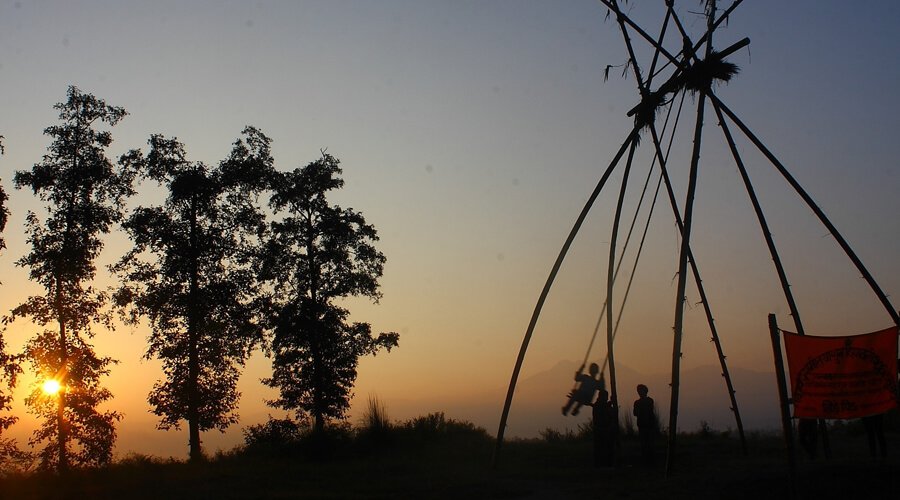
Dashain Festival is one of the major Hindu festivals which is primarily celebrated all over Nepal and also in places such as Sikkim with lot of joy and enthusiasm. This festival is most important for the Hindu Nepalese of Sikkim. This important Hindu festival, pays homage and honour to the great conquest of the gods over the evil demons. The victory is symbolic. Goddess Durga, the symbol of power, is worshiped ardently during this festival. The significance of Dashain is considerable in the life of the people in general, especially the Hindus. Dassain symbolizes the victory of good over evil which is symbolized by Goddess Parvati, an important deity for the followers of Shaktism of Hinduism. According to Hindu mythology, the demon Mahishasura had set upon a course of destruction and terrorized the heaven or the abode of the gods, the devaloka. But Gods then created Devi Durga to bring an end to this evil force and we find that ultimately Goddess Durga restores peace and order by killing the veritable rakshas or the powerful demon (the symbol of evil).
This festival occurs in the months of September or October and the rituals and ceremonies resemble the festivities of the celebration of Dusshera that is enjoyed in other parts of the country. Dashain primarily honours the prowess of Goddess Durga, who is a mighty creation evolving out of the combined shakti or energy of all the gods. She is depicted holding various weapons in each of her ten hands which she had received from each of the creator gods. Goddess Durga is worshipped for nine days starting from the first day or Prathama to the ninth day or Navami. Fasts, elaborate pujas, joyful gatherings, ornate puja pandals, wearing new clothes, visiting relatives and friends, exchanging gifts are some of the highlights of this festival.
On the tenth day, the elders of every family apply ‘tika’ or vermilion mixed with yogurt and rice on the forehead of young ones while the young people seek blessing from them. During this tenth day of Dashain, men and women are seen decked in their fineries visiting their elders to seek tika accompanied by blessings. Cash or gift in kind are at times given by the elders. At the end of the ritualistic puja, the statue of Goddess Durga is taken out in a colourful procession for its immersion in a water body, lake or river. This marks the end of Dassain.
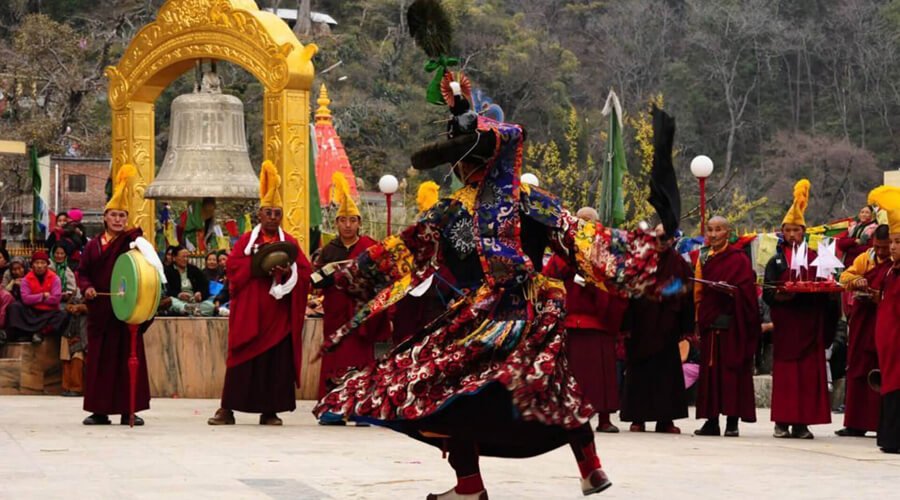
Losar or Lossar is important for the people of Tibet as it also the Tibetan New Year. This festival occurs in the month of February. It is celebrated by a lot of joyful festivities that involve inviting friends and relatives for family gatherings. Two days before Losar, the extravagant performance of Gutor Chaam is performed at Rumtek monastery. This performance depicts the battle between good and evil and the ritualized victory of good and consecutive destruction of evil. At Pemayangste also Lossar is preceded by Chaams or traditional dances.
Losar is celebrated with the same concept of other harvest festivals that are celebrated in India such as the Baisakhi. The devotees believe that if Gods and spirts are appeased they will then look after the well-being of the people in the forthcoming New Year. Losar depicts showing gratitude to the gods for blessings of harvest. When gradually Buddhism seeped into the Tibetan culture, celebrations of Losar was laced with Buddhist influences of various rites and rituals.Losar is celebrated on the 29th day of the 10th month. The festivities starts on the first day of the 11th month officially. The festivities are marked by the slaughtering of the goats and the sheep that are reared for the festivities.
In Sikkim, this Tibetan New Year is celebrated with a lot of fervour and enthusiasm. During this festival, which is also otherwise known as Gyalpo Lossar, visiting the monastery on the days of festivities along with visiting the relatives and friends after performing the rituals is practised. Flowers play an important role in the festivities of Lossar. Devotees pleasantly greet each other with flowers as a part of the ritual. Losar is also marked by immense merriment, joy and extensive feasting.
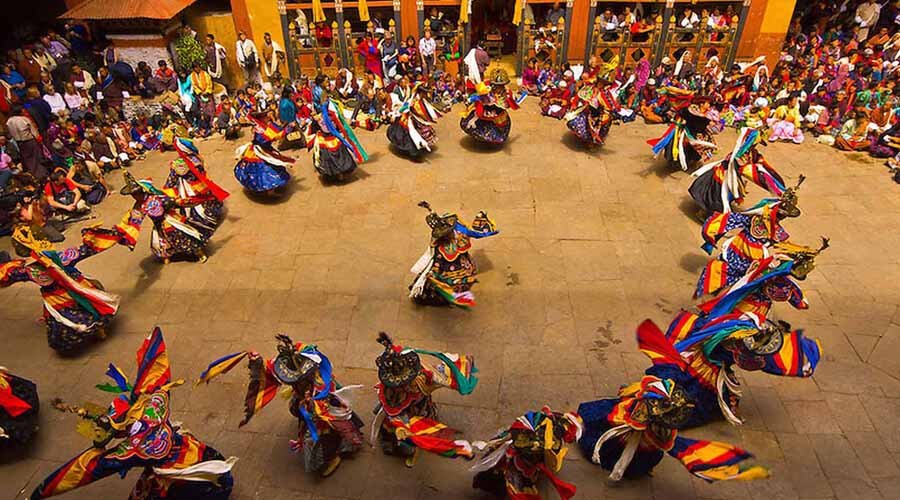
Losoong is also called Namsoong by the Lepchas and this festival is the Sikkimese New Year. It is a special harvest festival in which the farmers rejoice and celebrate their crop production or harvest. Thus it is celebrated at the end of the harvest season. Lasoong is predominantly celebrated as a private family ritual with friends and relatives. But the joy of festivities is to be found in the air all around. One of the main festivity or ritualistic dance is the Black Hat dance that depicts the victory of good over evil. Chaams are performed in various monasteries a couple of days before the festive dates of Losoong. This festival falls in the month of December every year and the spirits get joyful with traditional gaiety and colours of festive meeriment is contributed both by the Lepchas and the Bhutias. Certain competitions demonstrating traditional skills of the local people are also held as a part of celebrations. Archery is one main event that marks Losoong. The fun, feasting and merry making continue for days.
Rural Sikkim too joins in the festive spirits. During this festival, the lively masked and costumed Chaam dances are performed by the local artists. Festivities are to be seen in galore at the various monasteries of Sikkim such as the Phodong monastery, Tsu-La-Khang monastery and the Rumtek monastery.

Maghe Sankranti falls on the first day of the tenth month of the Bikram Sambat calendar. It marks the onset of warmer weather and is a major festival of the Nepalese. It is celebrated widely across all over Sikkim. As per the English calendar, it falls on the fourteenth of January every year. The devotees undergo a ritualistic bathing ceremony known as the Makkar. People in large numbers are seen take a dip at the confluence of the mighty rivers of Teesta and Rangeet. Makar Sankranti is considered an auspicious day that marks the beginning of the holy month of Magh according to the Hindu lunar calendar. Maghe Sankranti festival in Sikkim is marked by huge fairs or melas that are held in many places along the river banks and at the confluence of rivers.
Maghe Sankranti is known as Makker Sakranti in rest of the parts of India Usually, this festival is observed for three days. Among the fairs that are held in Sikkim, the biggest and the most awaited is the Jorethang Maghe Mela. This mela is held in Jorethang in south Sikkim. The mela as of today has assumed a lot of importance and have become a major event. It attracts hundreds of locals and curious tourists from all across. The mela is believed to have evolved from the agricultural fair that was conducted in Jorethang for the first time way back in the year 1955. In those days, the people of the neighbouring towns like Kalimpong, Siliguri and Darjeeling had decided to organize a small fair to find a place to easily sell their local produce and handicrafts at reasonable prices. The fair started off at a small local scale about more than 50 years back but has assumed the shape of an enormous tourist attraction holding colourful events and programmes. This programmes demonstrate a unique mix of age-old cultures and modern day entertainment options. Today, hundreds of stalls selling and exhibiting tempting products are on show for the huge number of people who gather in the fair.
This fair is an example of the most famous cultural festivals of Sikkim. Maghey Sankranti Mela is celebrated with a lot of grandeur in this scenic village of Jorethang each year. The flood of tourists who arrive here from different corners of the globe enjoy the various scintillating cultural programmes, take part in the gala food shows and get thrilled by the sports competitions like archery, para-gliding, trekking, hot air-ballooning and river rafting. This mela is an excellent platform for showcasing handicrafts and artwork of the local Sikkimese artisans. This results in a brilliant exposure for the intricate works of craft of these skilled workers in a global platform and forms an important aspect of this Maghey Mela. This fair provides a rich insight into unmatched cultural treasures of North East India. Thus this festival is a must-attend for those who are in love with the traditions and cultures of India.
The Maghey Mela Festival is focussed mainly on promoting tourism for the state of Sikkim. The spectacular mela lends the taste of authentic Indian traditions and the sight of thousands of devotees gathered at the confluence of rivers to take a holy dip and perform religious rituals is to be watched in awe and reverence. This fair is also alluring for music lovers, who remain enthralled by great performances of renowned singers and musicians who are often invited by the festival committee to enliven the spirit of the rejoicing and the standard of performances for the audience gathered from far and near.
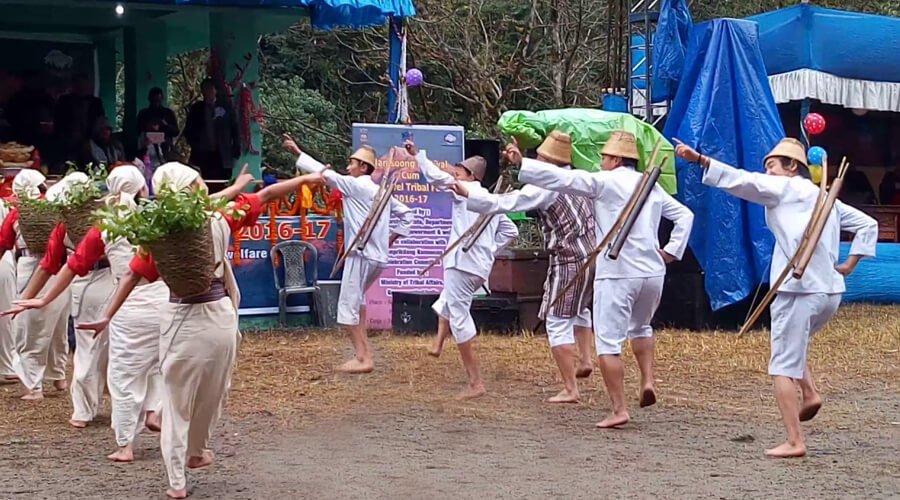
Namsoong Festival is gradually occupying its share of importance in the arena of the dazzling cultural fests of Sikkim. The festival of Namprikdang Namsoong is celebrated every year at the confluence of rivers Teesta and Tholung Chu in Upper Dzongu, which is a region located in the Northern part of the state of Sikkim. Namsoong festival marks the new year of the Lepcha Tribe of Sikkim and coincides with the Sonam Lossong festival of Bhutias. Namsoong provides a glimpse of a magnificent visual treat representing an array of colourful folk dances, some merry traditional games and some exotic and mouth-watering Sikkimese Lepcha cuisine. According to Dungkit Karchu or in other words the Lepcha Calendar, Namsoong festival begins from the first day of the ‘Kurneet Lovo’ that corresponds to the month of December or January every year. The festival continues for seven days. Thus these seven festive days are alluring enough for cultural aficionados, anthropologists, curious backpackers, historians, offbeat travellers, families and honeymoon couples to plan their trips to Sikkim.
History of the Festival says that the celebrations for Namsoong began in the year 1976 on the Namprikdang ground. This area is a small and grassy flatland in the Dzongu valley and is considered to have a mythological association. The Lepchas believe that this ground connected the Lepchas to the mythical abode known as the Mayal Lang Country belonging to the Lepcha ancestors. This place was surrounded by thick forests and captivating towering hills on all sides. It was the local belief of the Lepchas that all mortal soul from their community with goodness of spirit who die get to navigate through this nature’s blessed cradle to reach their heavenly abode finally. There are a number of other interesting Lepcha legends and mythological stories that are connected with Namprikdang that makes this enchanting and enigmatic. These stories are tempting enough to keep the locals bewitched and historians and researchers interested. Various curious travellers come to this place to get an insight into actual beliefs of these local folklores. Naprikdang Namsoong provides the outsiders a genuine peep into their culture and allow them to carry on with their research work uninterrupted while enjoying the Lepcha hospitality and traditions.
The festival continues for 15 days that falls during the months of December and January every year at the very Namprikdang Ground beside the holy confluence of Rivers Teesta and Rangeet. A beautiful traditional Lepcha house that commemorates the resting place of their ancestors remains the main venue for the carrying out the traditions of the festival. Traditional Lepcha dances are showcased along with temporary restaurants and food stalls serving authentic Lepcha cuisine, comprising mainly roasted pork, beef and Chhang, that holds a promise of a happy time for all the guests, especially the locals and the travellers who attend the festivities. The Lepcha Shamans or priests perform various religious rituals and offer prayers to Mt. Kanchenjunga and to the Lepcha ancestors on the day of the celebrations. These unique customs and practices keep all the tourists in awe and stun the onlookers with the unique cultural legacy.
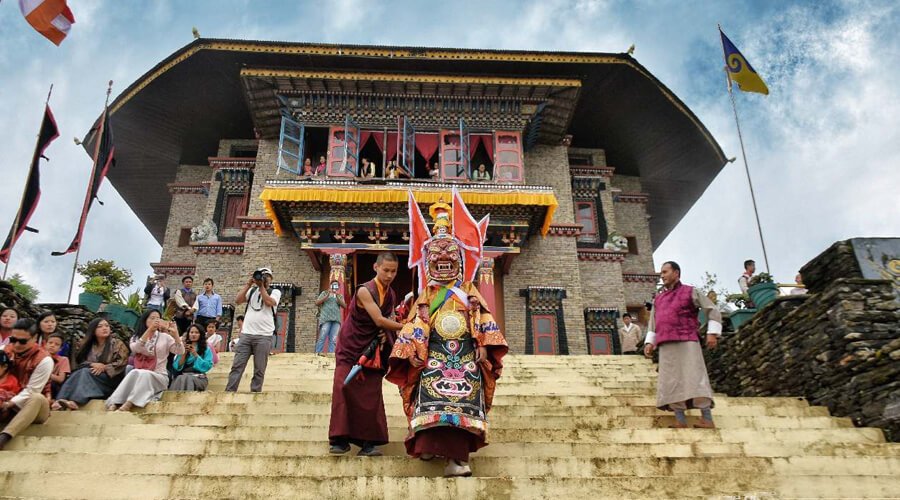
This festival is counted as among the most popular regional and cultural festivals of Sikkim which is unique to the state. The festival commemorates the consecration of Mount Khangchendzonga as the most important guardian deity of the people of Sikkim. The people of Sikkim also believes that the mountain god posed as an important influence behind the introduction of Buddhism in this former kingdom. According to the biography written by Lhatsun Chenpo, who is known to be the chief propagator of Buddhism in Sikkim, the Khangchendzonga mountain god had sent divine visions that guided him to Demajong or this hidden valley of rice. Sikkim is referred to by the as ‘the hidden valley of rice’ by the Bhutias.
To pay homage to the mountain god, till this day the people invoke him and offer prayer during the Pang Lhabsol celebration for continued protection of Sikkim. Pang Lhabsol is celebrated on the 15th day of the 7th month of the Tibetan calendar that falls between late August and early September. The ‘chaams’ that are performed during this festival are unique and the spectacular Pang-toed or warrior dance, as it can be described, was initiated and first choreographed by the third Chogyal Chador Namgyal. He is said to received visions of this dance form. On a note of further camaraderie, the festival also marks the commemoration of blood brotherhood that was signed between the Lepchas and the Bhutias at Kabi in the 15th century. The festivities include carnivals, cultural performances, lama warrior dances and a variety of delectable authentic Sikkimese cuisine that are enjoy by all who gather here.
Pang Lhabsol ia a major attraction to countless tourists and visitors from across India and different other parts of the world. The colours of the festival bathes the land with an unparalleled aura of positivity and colours all around, bringing all the people of the state together and soaked in the spirit of joyous celebrations and festivities. For the cultural aficionados this time is an ideal time to plan a trip to Sikkim to be able to witness and admire the spellbinding ethnic and traditional legacy of Sikkim.
All local communities of Sikkim including Bhutias, Lepchas and Nepalis take part in the festivities with great enthusiasm depicting a happy picture of communal harmony in the state. The colourful festival of Pang Lhabsol has elaborate rituals, prayers and thrilling dance performances by monks and lamas. The Pang-Toed Chaam is the most thrilling and enjoyable of all and keeps all visitors entranced. This awe-inspiring warrior dance is performed to invoke the guardian deity, Mt. Kanchenjunga. During this dance performance, Lamas wear brilliantly hued costumes and fiery red masks with crown of five skulls. They ride on a snow-lion which represent the guardian angel and add to the glitter of the show accompanied by the rhythmic dance steps and acrobatic moves with resonant beating of drums and echoing clang of cymbals. The entry of Mahakala who is looked upon as the protector of Dharma, is a spectacle that audience waits for breathlessly and this brings about a dramatic highpoint in the performance.
For the monks of Sikkim, Pang Lhabsol is a celebration of togetherness and a time for allegiance to the ultimate deity with earnest prayers for protection the year round. The serene Rabong Monastery houses a peaceful and serene ambience and prepares for the extravaganza of the celebrations well. People from far corners gather here. The monastery also offers picturesque glimpses of the mighty Khangchendzonga. That view enhances the importance of worshipping and showing veneration to the deity. The glimpse of the mountains can be enjoyed beyond the Buddha statue at the Buddha Park. Pang Lhabsol involves worshipping Dzonga which is the representation of Mount Khangchendzonga, Gonpo that signifies Mahakaal and Dragpo Deshi who is the guardian of the four directions.
In Gangtok, the Pang Lhabsol is celebrated grandly near the Tsuklakhang Monastery at the Rabong Monastery in Ravangla, old Ralong Monastery and at Kabi Lungchok in North Sikkim.
The history of Sikkim says that during the eight century, Guru Rinpoche had warned the Tibetan King Trisong Detsan that Tibet would be losing its sovereign status in the near future. Thence, the King requested the Guru to leave Tibet and search for places to spread the goodness of Dharma. Guru Rinpoche completed his spiritual quest in Tibet and then selected four major hidden lands and four minor hidden lands around Tibet to spread the essence of Buddhism. He had been to Gurudongmar Lake in North Sikkim and Tashiding in West Sikkim. He sanctified the whole of the adjoining regions marked as Hidden Land or Beyul Demajong in the Buddhist circles. This spiritual ascetic explored various parts of Demajong and meditated in caves in the four directions surrounding the Tashiding Monastery and purged the land from a number of demons and spirits.
Pang Lhabsol involves a ritualistic reading out of text known as Neysol, which is read for three days by the monks. On the last day, the festival sees a few dramatic rituals such as shaylen or the oral oath of protection, dzongkhor or the victory song and the Pangtoed Chaam or commonly known as the warrior dance. The Chhaam dance was a result of the enthusiasm of the third Chogyal of Sikkim, Chador Namgyaland , and this warrior dance signifies the loyalty and devotion towards the Chogyals along with the Guardian deity.
The recitation of the spiritual text invokes the mountain deity. During the festival, the Rabong Monastery is decorated colourfully with the monks and devotees wearing colourful traditional dress. The dancers dress in the traditional Sikkimese battle dress and are properly equipped with helmets, swords and shields where even the Mount Kangchendzonga is represented by a dancer wearing mask mounted with five human skulls topped with mounted flags and Mahakaal, the protector of Dharma or faith, also makes an appearance in a mask garb. The flexible acrobatic step keep the audience amazed . The masked dances are definitely a sight to behold with precise coordinated and elegant movements. The dancers demonstrate physical fitness, strong and quick reflexes with skill in swordsmanship. The warriors demonstarte the act of pledging to protect the kingdom of Sikkim, and the Chogyal along with the guardian deities. Mahakaal is depicted blessing the land and instructing the mighty Kangchendzonga to look after Sikkim.
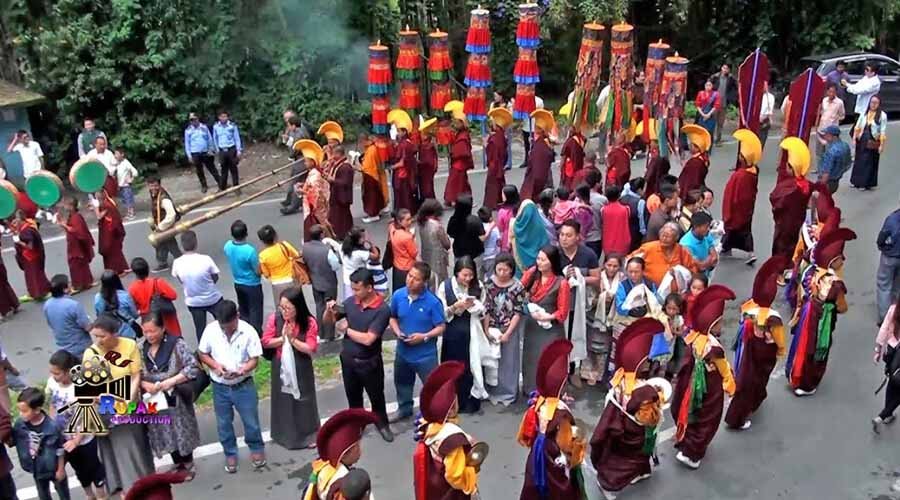
Saga Dawa is also known as the Triple Blessed Festival and is one of the major festivals of Sikkim. It is identified as an auspicious month for the Sikkimese Buddhists who celebrate with prayers that are conducted throughout the month of Saga Dawa in the various monasteries. This festival is celebrated on the full moon of the fourth month of the Tibetan calendar which is celebrated as Buddha Purnima in the rest of India. It falls on May or early June as per English calendar. The devotees believe that on this day Lord Buddha was born and he had attained Enlightenment and had achieved Nirvana on this occasion.
Saga Dawa is celebrated with great pomp and glory every year. The festival forms an important religious aspect for the followers of Mahayana Buddhism. For the curious travellers and cultural and traditional enthusiasts, Saga Dawa is another great occasion to have a peep into the interesting Buddhist culture. Saga Dawa offers a visual treat in the form of various pompous religious ceremonies and lively street processions. Among the several religious rituals, reading of holy scriptures called ‘Kajur Texts’ and lighting of butter lamps take place during the entire month. Donating to the poor and needy and giving alms are quite common practices as these acts of generosity are believed to carve out the path of salvation for the souls towards Nirvana.
The history of the celebration of Saga Dawa or the Tripe Blessed Festival dates back to many years ago in 1950 when this date was officially assigned for the festivities at the first conference of the World Fellowship of Buddhists held in Sri Lanka. This festival is celebrated across the world in various different ways and under various different names. The Tibetans and Sikkimese celebrate it as Saga Dawa whereas in some South East Asian countries like Singapore, Indonesia, Malaysia and Sri Lanka this festival is celebrated under the name of Vesak Day. In India, apart from the North Eastern regions, the festival is popularly celebrated as Buddha Purnima.
Through the auspicious festivities of Saga Dawa, the people remember their favourite lord and his life from the time when he was born in Lumbini in Nepal. Lord Buddha had realized that worldly pleasures are ephemeral very early in his life. Therefore, he had to look for the ultimate truth of life. At the age of 35, he had attained ‘Nirvana’ or ‘moksha’ after meditating for years in Sarnath. The enlightened one passed away or attained parinirvana at Kusinagara at the age of 81. Saga Dawa marks the life stages of the mystical Lord, who had eventually gone into spiritual ecstasy.
The celebrations of the festival is done by taking out elaborate and colourful procession of monks playing musical instruments while the devotees accompany carrying holy texts, portraits and statues of Lord Buddha. The processions are a common feature in the streets of Gangtok as well as in other smaller towns and villages of Sikkim. People flock to the streets during the procession to seek blessings by touching their heads on the holy scriptures. One major highlight of Saga Dawa is the lighting of butter lamps in monasteries by the Mahayana Buddhists. This ritual indicates the display of honour and respect by the Mahayana Buddhist devotees towards Lord Buddha who is believed to have enlightened their way of life. After the rituals are performed, a grand procession starts from Tsuk-La-Khang Monastery in Gangtok, which is led by monks carrying holy scriptures and portraits of Lord Buddha. The rendition of Buddhist hymns and chants that resonates among the streets of Gangtok, presents a grand show to the delight of the onlookers. Saga Dawa is a good time to plan a trip to Sikkim for a more intimate tryst with Buddhist culture and traditions of Sikkim.
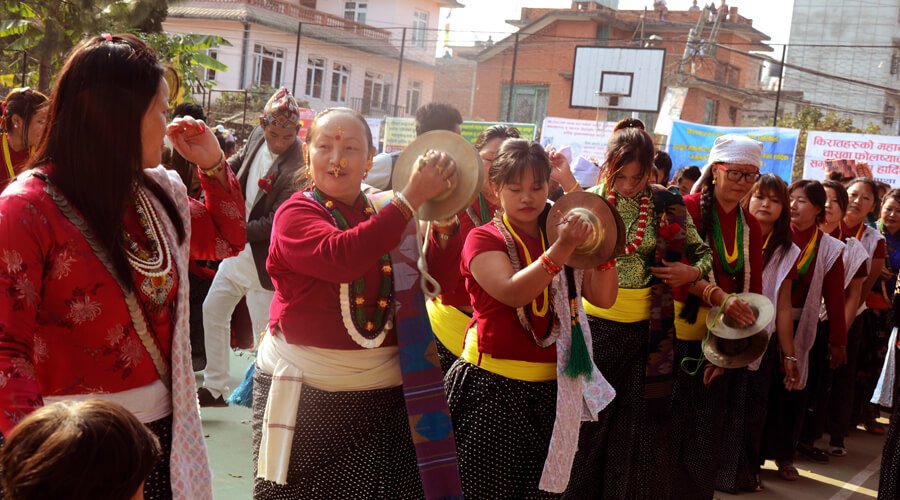
Sakewa festival, also known as the Bhoomi Puja or Chandi Puja is celebrated with great enthusiasm by the entire Rai community. It is one of the oldest festivals of the state of Sikkim and a major harvest festival in which nature is worshipped. It is also commonly referred to as Bhoomi pooja or land worshipping ceremony. The Kirat Rais are basically worshippers of nature and during the festival of Sakewa the devotees offer prayers to the natural supreme power who is also the creator of the universe. They pray for peace, protection and well-being of all living and non-living things in the universe. It is a significant cultural and religious festivals for the Kirat Khambu Rai community in Sikkim. The main focus of the festival is to pay homage to Mother Earth. The rituals commence through the performance of Bhumi Puja that is followed by community dances and other usual festive rituals. The entire state of Sikkim gets dressed up in the joy of festivities during Sakewa and the air resonates with the vibrant sounds of drums and cymbals. The people all around absorb the festive fervour and join the mirth of merry making and celebrations with full enthusiasm. The people and eager tourists who are genuinely interested in the culture and magnificence of Sikkim traditions can plan their trip itineraries matching the dates of the cultural extravaganza of the Sakewa festival.
The Kirat Rai community is thought to be among the most ancient people residing in the heart of Himalayas. This community is an ardent worshipper of nature and many of their traditions are connected towards showing reverence to nature gods and praying for common good of all living creatures existing on the face of earth since creation. Sakewa is a nine-day long festival that begins on the full moon day of the Hindu month of Baisakh which corresponds to the months of April or May according to English calendar. The celebrations symbolize the beginning of the new farming year and start off on a chosen venue that might be a big ground or a hill top. The ceremony is initiated by the Mangpa or the male priest or sometimes Mangma or the female priest who perform puja of the soil. After observing several other religious rituals, also community feasts are also arranged. After the common celebrations conclude, people reach back their homes to perform the holistic rites addressing their fore-fathers. As a part of the ritual, they offer food grains, millets and ginger to a fire lit in the hearth. The celebration continues for nine days. The celebration concludes on the ninth day with the ritual of sowing seeds in the fields.
Sakewa Sili or ceremonial dances are an integral part of Sakewa festival. These dances have a uniqueness of charm and a special significance. Dances are exclusive where the performers are seen in various different postures that depict the behaviour of animals, birds, etc . This gesture is towards an expression of gratitude to the creator. Offering to Lord Kubera, the Hindu god of food and wealth, is a major highlights of the Sakewa festival. The Sakewa Sili dance which is performed by the community women in the form of a prayer to Mother Earth to bless with a good crop in the forthcoming year is the most popular among all. The silis comprise 108 characters of different animals and birds. After offering puja, the worshippers consume wachipa, which is a unique and specific dish prepared from chicken feathers. Another sili performance which is known as the Chasum Sili depicting the entire cycle of sowing to reaping to cooking and eating the rice is also very popular and enthrals the tourists and travellers.

Sonam Lochar is a major festival of the Tamang community. It falls in the month of Magh according to the Bikram Sambat Calendar. The festival falls in the month January and February on the occasion of Magha Shukla Paksha which falls in the spring season. Various communities, especially the Tamangs, also celebrate their festival with great joy and religious fervour. The celebrations last for five to fifteen days varying in duration in the various regions. The Tibetan calendar is composed of twelve lunar months and the festival of Lhosar begins on the first day of the first month. The dates of celebration differs according to various different Tibeto-Burman communities.
Sonam Lhosar festival is majorly celebrated by the Buddhist community of Nepal. Where the word Lhosar refers to New Year and Lhosar usually falls during the months of January, February or December as per the lunar calendar. Sonam Lhosar is the year of a Wood Horse. The festival of Lhosar is grandly celebrated by visiting monasteries and stupas. These religious centres are also the venues for special rituals with mask dances which are performed to drive away the evil forces and spirits. The Tamang people also make their best efforts to keep their houses and surroundings clean so as to welcome the gods and goddesses.
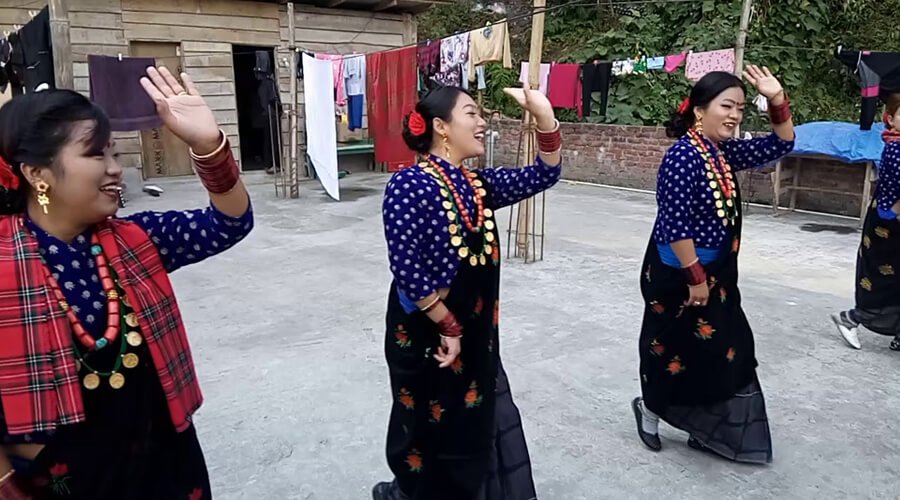
Tamu Lochar is a major traditional festival celebrated by the Gurung Community. It marks the beginning of the Gurung New Year and it is celebrated on the 15th day of Pusa, according Vikram Sambat calendar and falls on 30th December according to English Calendar. The festival is celebrated with the family members and by the community as a whole. Tamu Lochhar denotes the end of harsh winters and bring in the sweetness of the spring season. The history of this festival goes back to pre-Buddhist era of Sikkim.
Tamu Lochhar is a grand festival of the Nepali-Buddhist community and is celebrated majorly by the Gurung Community in Sikkim and is also celebrated in the neighbouring states of North East India. The family members and friends gather together to exchange greetings and well wishes. A huge number of fairs are held at various places across the state of Sikkim where locals and tourists join in celebrations. These festivities are marked by colourful and joyous cultural programs, enjoying traditional food of the Gurungs in the varied food stalls and watching the thrill of on-the-spot competitions. Tamu Lochhar is a good time to plan your trip to Sikkim in order to watch the festive revelry and to experience the unmatched hospitality of the Gurungs.
Festive spirits of the Gurung community are at their best as the people gather at a common ground to celebrate the occasion by singing, dancing and feasting on the traditional Gurung food that comprises ‘Sel Roti’ and ‘Achaar’. The day of the festivity of Tamu Lochhar is begun by the people of Gurung community who attend the monasteries and shrines to pray for a happy and prosperous beginning of a brand new year. Later on, the families and friends get together and exchange festive greetings while the youngers seek blessings from the elders. It is heartening to watch the people getting attired in their traditional dresses to visit the fairs. The people enjoy all kinds of entertaining activities such as music, dance, joy rides for kids.

Tendong Lho Rumfaat is a festival of the Lepcha people of north-east India and is celebrated in Sikkim with great enthusiasm. The festival falls usually in the month of August as per English calendar. The story goes that the Lepcha ancestors went to the top of the Tendong Mountain in order to escape from 40 days and 40 nights of continuous rain. The festival commemorates this phenomenon. It is one of the oldest festivals of the Lepchas and is celebrated for three days. The celebrations start with the offering of prayers to Mount Tendong in South Sikkim. According to legend, the Lepchas believe that Mt. Tendong had saved the Lepcha people during the great flood which engulfed the entire Mayel Lyang country, which is currently known as Sikkim. The festival of Tendong Lho Rum Faat is an annual thanksgiving to the saviour mountain. Literary and cultural programmes are held in Gangtok to mark the occasion. Display or exhibition of traditional Lepcha food, costumes and ornaments are to be found on the last day of celebrations.
The festival is celebrated with full enthusiasm throughout the state of Sikkim. The most important venue for festivities is at Namchi, which is the home to the sacred hill. A great carnival is organised here that attracts huge crowd. Mount Tendong, located in South of Sikkim. A trek that starts from Ravangla goes up to the Tendong Hill and is an important part of celebration during this beautiful festival. This trek passes through scenic mountain terrain, sparkling rivulets and dense mountain forests. This activity forms a great attraction for trekkers and adventurers who travel to these parts from all corners of India to satiate their thirst for adventure and also to absorb the cultural and mythological essence of the local tribal communities.
The Lepcha mythology also says that at the time of earth’s creation when Himalayan Range was just as the early stage of formation, a massive volcanic eruption had destroyed Naho and Nather Pokh, which were the sources of Rivers Teesta and Rangeet. Thus began the onslaught of continuous rains for 40 days. This was the cause of rampant floods and considerable loss of life and property. This also resulted in the near destruction of Lepcha tribe, who it is believed were the prime inhabitants of earth. And then the miracle happened where the Tendong Hill rose like a horn from the head of a deity and the Lepcha ancestors saved themselves from being completely destroyed by climbing up the mountain. Thus, then onwards, the Lepchas worship this holy Tendong Hill, which when translated in English means ‘the hill of the raised horn’ and pay their homage with utter reverence to the creator who had helped save their ancestors. As a mark of celebration, the Lepcha people build models of the Tendong Hill at the entrance of their façade and worship it while they pray for a happy and prosperous life. The model is exclusively made out of nine stones and the devotees dance and sing wearing mask to receive the blessings of the almighty.

The famous Bumchu Festival is celebrated in the Tashiding Monastery on the 15th day of the first month of the Tibetan calendar. Bhumchu is usually celebrated on the 14th and 15th day of the first month of the Tibetan lunar calendar and these dates usually fall sometime in the months of February or March.
A sacred pot or Bhumchu contains holy water which is believed to have been blessed by Ngadak Sempa Chenpo after he chanted the Mane Mantra five billion times. And Bumchu festival involves the opening of the vessel containing the holy water and revealing it. Bumchu is one of the holiest festivals in Sikkim. The level of water in this vessel is believed to predict the fate of Sikkim for the entire year and is a sign of the what fortune awaits for the people of Sikkim in the coming year. Every year, the vessel is opened to check the level of water in it. It is believed that if the water level in the Bumchu is high till the brim then it is a warning for revolutions and turmoil and if it is lower than what has been specified then ill fortune such as droughts, diseases and various aliments are to be expected. A half-full Bhumchu ushers happiness and predicts that the year will be a prosperous one.
The festivities or the ceremony of checking the water level is accompanied by a special recitation by the devotees. It is a ritual to check the seal of the vase before it is taken out of the case. After opening the vessel, the monks fill seven cups of water from the water of the Bumchu and mix it with water from Rathong Chu. This sacred water is then distributed among the devotees by the lamas of the Tashiding Monastery. To replenish the Bumchu vessel again, seven cups of water are taken from Rathong Chu and poured into the vase to be sealed until the ceremony again the following year. It is miraculous that over the centuries the holy water has not dried up. The water has not even been spoilt even after more than 300 years. It still smells and looks fresh. Thousands of curious devotees from all across Sikkim and the neighbouring countries like Bhutan, Darjeeling, Nepal. attend the Bumchu festival.

Trungkar Tsechu celebrates the birth anniversary of Guru Padmasambhava, who is the patron saint of Sikkim. This festival is celebrated with great pomp and grandeur in the state. Guru Padma Sambhava also known as Guru Rinpoche was the founder of Tibetan Buddhism who had first introduced Buddhism in Sikkim and other neighbouring Himalayan regions during the eighth century. The date of the festival falls on the tenth day of the fifth Tibetan Lunar calendar, which coincides with the months of July and August every year. The ancient and happening Rumtek Monastery of Gangtok serves as one of the primary venues for the festival. Rumtek Monastery is widely known as a superior example of artistry and grandeur along with all-pervading peace and harmony. This venue thus makes for an ideal venue and the celebrations of Trungkar Tsechu are attended by thousands of devotees and tourists alike.
In Gangtok, a procession carrying the statue of the Guru Padma Sambhava is taken around the town. Spectacular performances of Chaams are performed at Rumtek monastery celebrating various different episodes from the life of the Guru. This birth anniversary of Lord Guru Padma Sambhava, who was the founding father of Buddhism in the Himalayas, is celebrated by offering prayers usually every month on the 10th day in all the Buddhist Monasteries in Sikkim which is celebrated as Tshechu as a prayer for peace and prosperity.
Guru Padmasambhava, is undoubtedly the most adored patron saint of Sikkim and he is believed to have introduced the Tantric and Vajrayana Buddhism in the region after defeating the demons during the eighth century AD. The Guru is considered fondly as the ‘Second Buddha born on the Lotus Flower’ and he is held in high esteem and immensely revered by Buddhists of Sikkim and other regions in the world. The concept of Trungkar Tsechu was initiated by the Guru Rinpoche himself. Legend has it that the Guru had manifested himself in eight different human forms and danced in front of a demon to conquer him. Later on, these dances came to be known as ‘Chaams’ and exhibit the glory of the patron saint during some Buddhist festivals.
Celebration involves a huge fanfare. A great pomp and show pervades throughout the state. The devotees offer special prayers and perform a wide array of rituals in the monasteries and one can enjoy the fiesta of huge processions being carried across the streets that are led by monks and lamas who play various traditional instruments. The whole state of Sikkim comes to life on these festive days of Trungkar Tsechu. Huge processions can be seen carrying statue of Guru Padmasambhava in the streets of Gangtok. The air gets filled with the resonant chanting of “Om Ah Hung Vajra Guru Padma Siddhi Hung Rhi” by the long line devotees and followers. In the monasteries of Sikkim, special prayer services are held and blessings are sought from the great patron saint. The Chaam dances depict eight manifestations and various episodes from the life of Guru Padmasambhava that enthrals the audience and also fill all with a renewed sense of reverence.
An experienced Sikkim tour operator, with a team of an experienced travel enthusiast ensure to give our clients well-designed Sikkim Gangtok tour packages.
Sikkim Tourism has received numerous accolades from its happy customers for its excellent services and best Sikkim holidays.
We have local office in Sikkim for our customers to find assistance anytime and anywhere.
Do not hesitage to give us a call. We are an expert team and we are happy to talk to you.
+91-9810066496
info@sikkimtourism.org
